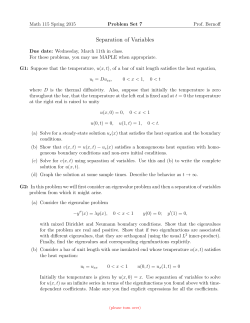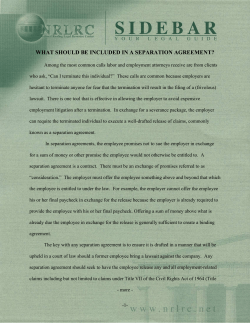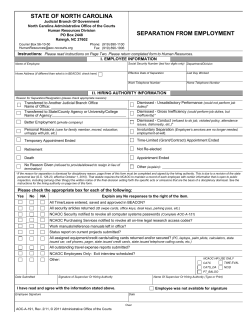
experimental open-loop and closed
European Drag Reduction and Flow Control Meeting – EDRFCM 2015 March 23–26, 2015, Cambridge, UK EXPERIMENTAL OPEN-LOOP AND CLOSED-LOOP CONTROL OF A MASSIVE SEPARATED BOUNDARY LAYER AT HIGH REYNOLDS NUMBER C. Raibaudo Laboratoire de M´ecanique de Lille (LML), CNRS UMR 8107, Villeneuve d’Ascq, France ´ Ecole Centrale de Lille, Boulevard Paul Langevin, Villeneuve d’Ascq, France A. Polyakov Inria project-team Non-A, Parc Scientifique de la Haute-Borne, Villeneuve d’Ascq, France Centre de Recherche en Informatique, Signal et Automatique de Lille (CRIStAL), CNRS UMR 9189, Villeneuve d’Ascq, France J.P. Richard Inria project-team Non-A, Parc Scientifique de la Haute-Borne, Villeneuve d’Ascq, France Centre de Recherche en Informatique, Signal et Automatique de Lille (CRIStAL), CNRS UMR 9189, Villeneuve d’Ascq, France ´ Ecole Centrale de Lille, Boulevard Paul Langevin, Villeneuve d’Ascq, France F. Kerherv´ e, M. Stanislas Laboratoire de M´ecanique de Lille (LML), CNRS UMR 8107, Villeneuve d’Ascq, France ´ Ecole Centrale de Lille, Boulevard Paul Langevin, Villeneuve d’Ascq, France (contact : michel.stanislas@ec-lille.fr) INTRODUCTION The control is realized with 22 round fluidic jets distributed in the spanwise direction upstream of the separation line. The configuration of the jets generates co-rotating vortices which re-energise the near-wall region, and force the flow reattachment, depending on the actuation parameters of the jets. More details on the experimental setup can be found in [2, 7]. Developing flow control strategies has been an important effort in the last decades to avoid separation of boundary layers mainly for aerodynamic gains. Active flow control with fluidic actuators is nowadays a well-known solution to remove or reduce significantly the separation. Pulsed actuation has been particularly studied as a technique using less flow rate with similar performances as continuous blowing [3, 5, 6, 8]. In order to increase the control performances (precision, dynamics, resistance to flow perturbations...), feedback closed-loop control can be chosen [1, 9]. U∞ 0.75 m jets hot-films PIV field α β Hs The present study addresses open-loop transient characterization and closed-loop control of a mostly two-dimensional turbulent boundary layer with massive separation under a pulsed fluidic actuation. Contraction ( 1.33 m ) Flat plate ( 2.10 m ) Flap ( 0.34 m ) Figure 1: 2D-sketch of the AVERT ramp used for the experiments. EXPERIMENTAL SETUP OPEN-LOOP EXPERIMENTS The experiments are conducted in the LML boundary layer wind tunnel in Lille, France. A two-dimensional ramp is used in the wind-tunnel to generate a mild adverse pressure gradient and force the separation of the incoming boundary layer (fig. 1). At a wind-tunnel velocity of U∞ = 10 m/s, the boundary layer thickness is δ = 0.19 m and the Reynolds number Reθ based on the momentum thickness θ just before the flap leading edge is up to 12600. The separation is massive and the separation length is Lsep = 0.59 m, using the backflow coefficient χ criteria [4]. The transition between the separated and attached flows is studied in details. Simultaneous velocity and friction gain measurements are performed during this transition. Phaseaveraged velocity fields are obtained from 2D-2C PIV oriented in the streamwise direction and normal to the wall (fig. 2). Hot-film sensors placed along the separation region provide instantaneous measurements representative of the skin-friction. These friction gain measurements allow firstly to have timeresolved informations on the transition, not accessible with 1 Figure 3: Experimental setup for closed-loop experiments. Figure 2: 3D-sketch of the AVERT ramp and 2D-2D PIV setup used in the study. ACKNOWLEDGEMENTS The present work was supported by the Agence Nationale de la Recherche (ANR) through the French ANR project SEPACODE and by the CISIT International Campus through the Contra´ ero project. The authors are indepted to Christophe Cuvier for his help during the experiments and for the PIV images processing, and Jean-Marc Foucaut for his helpfull assistance. low-speed PIV, and then to use these sensors as real-time inputs for the closed-loop experiments. Continuous and pulsed actuations are considered here and the effect of main actuation parameters (velocity ratio VR, frequency f , duty cycle DC) on the control efficiency is studied. These informations, particularly from the hot-film sensors, are considered as representative of the flow state during the transition. To design efficient closed-loop control, accurate models of transient dynamics, particularly the reattachment process, are necessary. Characteristic times of the transition (rising time, delays) are firstly obtained by fitting a first-order law on the hot-film sensors responses. For a better approximation of the flow dynamics during the reattachment, advanced models are also considered, based for example on the separation length or using input-output polynomial models. REFERENCES [1] R. Becker, M. Garwon, C. Gutknecht, G. B¨ arwolff, and R. King. Robust control of separated shear flows in simulation and experiment. Journal of Process Control, 15(6):691–700, September 2005. [2] C. Cuvier. Active control of a separated turbulent boundary layer in adverse pressure gradient. PhD thesis, Ecole Centrale de Lille, 2012. CLOSED-LOOP EXPERIMENTS [3] J. Kostas, J.-M. Foucaut, and M. Stanislas. The Flow Structure Produced by Pulsed-jet Vortex Generators in a Turbulent Boundary Layer in an Adverse Pressure Gradient. Flow, Turbulence and Combustion, 78(3-4):331–363, February 2007. Based on these models, closed-loop control had been realized. The experimental setup, specific for closed-loop control, is presented in figure 3. Instantaneous friction gain from hotfilm sensors is the measured output. The duty cycle for the jets pulsed signal is the control input generated with these informations. Several closed-loop algorithms had been tested. Feedback laws based on P, PI and PID algorithms have firstly been performed. The controller objective is to minimize the difference between the hot-film sensor signal and a target defined by the users. The behaviour and performances (mainly, small overshoot and high response speed) have been modified by means of an adequate tuning of the parameters (P, I and D gains). Optimal LQR control (Linear-Quadratic Regulation) is also considered. The actuation cost can now be taken into account in the controller through the minimization of a cost function. The influence of sensors noise on the closed-loop control performances can also be reduced by using estimators. Kalman filters are implemented in order to estimate the separation length from informations obtained from hot-film sensors and the duty cycle. A closed-loop control (named LQG - LinearQuadratic Gaussian) is realized using this estimation. Unavoidably, uncertainties of the controlled system can appear. Dynamical models are not perfectly defined and the incoming flow can be perturbed. Consequently, control performances can be deteriorated under these uncertainties. A robust control based on H∞ synthesis is realized here in order to reduce the influence of these uncertainties on the control performance. The objective is to maintain the control robustness for a system submitted to random perturbations and system uncertainties. The robustness of few controllers was tested experimentally with perturbing the incoming boundary layer before the leading edge. [4] O. L¨ ogdberg. Turbulent boundary layer separation and control. PhD thesis, 2008. [5] R. Mathis, A. Lebedev, E. Collin, J. Delville, and J.-P. Bonnet. Experimental study of transient forced turbulent separation and reattachment on a bevelled trailing edge. Experiments in Fluids, 46(1):131–146, August 2008. [6] K. R. McManus, H. H. Legner, and S. J. Davis. Pulsed vortex generator jets for active control of flow separation. In 25th AIAA Fluid Dynamics Conference, Colorado Springs, USA, June 1994. American Institute of Aeronautics and Astronautics. [7] C. Raibaudo, F. Kerherv´ e, and M. Stanislas. Characterisation of the transient dynamics of a controlled separated flow using phase averaged PIV. In Vassilis Theofilis and Julio Soria, editors, Instability and Control of Massively Separated Flows, pages 183–188. Springer, 2015. [8] P. Scholz, J. Ortmanns, C. Kahler, and R. Radespiel. Leading Edge Separation Control by Means of Pulsed Jet Actuators. 3rd AIAA Flow Control Conference, 46:837– 846, June 2006. [9] T. Shaqarin, C. Braud, S. Coudert, and M. Stanislas. Open and closed-loop experiments to identify the separated flow dynamics of a thick turbulent boundary layer. Experiments in Fluids, 54(2):1448, January 2013. 2
© Copyright 2025












